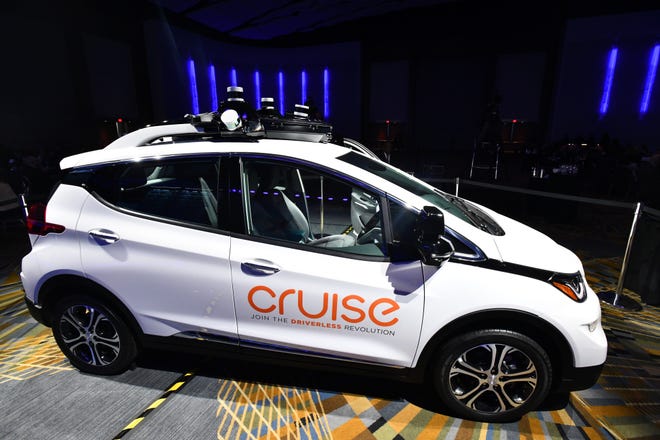GM quiet about Cruise driverless taxi fleet as deadline looms

As the self-imposed deadline for the self-driving taxi service from General Motors Co.'s autonomous vehicle development unit looms this year, the San Francisco-based GM Cruise LLC has gone quiet.
Hype for Cruise's potential built up in late 2017 and into 2018 as the former start-up laid the groundwork for a commercial launch of its autonomous technology. Increasingly, however, company leaders have said a launch of Cruise's driverless taxi service would be "gated by safety," a hedge that has been repeated since October when GM's self-driving unit partnered with Honda Motor Co.
Meantime, the industry at large has started pulling back on some of its autonomous-vehicle optimism. A fatal accident involving one of Uber's self-driving test vehicles spurred an industry-wide reassessment of how to best validate the complex technology required to make a car navigate public roads without the help of a driver. As investors and industry observers wait to see Cruise's robo-taxi service in action, experts say the 2019 deadline is hardly a deal-breaker for the driverless-vehicle unit's future.
"The real question is not whether Cruise is on track for 2019 or not — it's whether GM has the stomach to gut this thing out to completion and do everything it's really going to take to get there," said Mike Ramsey, an automotive analyst for research firm Gartner Inc. "Does GM have the stomach to spend money — that they don’t have a ton of — and sacrifice areas that make money now to stick this out?"
GM is trying to prove as much. The company is executing a sweeping restructuring that includes stopping production at five North American plants and cutting 15 percent of its salaried workforce. The goal is to cut costs and redirect precious capital toward expensive autonomy, electrification and mobility efforts.
The rollout of the technology has always been guided by safety, a Cruise spokesman said, reiterating what GM and Cruise executives have said in recent months. Leaders also say the quiet period for Cruise is a result of the Silicon Valley workforce's focus on getting the technology right.
GM is planning to spend roughly $1 billion on Cruise in 2019 after spending about $700 million last year. That includes hiring another 1,000 people over the next nine months. Cruise has also garnered some $5 billion in outside investments from Japan's SoftBank Investment Advisers and Honda.
And executives say a change in leadership ushers in a new phase for the self-driving car unit. Former GM President Dan Ammann took over as CEO of Cruise effective Jan. 1. He replaced co-founder Kyle Vogt who moved into the role of chief technology officer. Ammann and Vogt say the shuffle allows both executives to focus on their strengths as Cruise moves toward deployment.
But Cruise's original vision of a driverless taxi fleet of cars without steering wheels or pedals is still stuck in neutral more than a year after the company asked NHTSA permission to put the cars on public roads. It took NHTSA about 14 months to respond to the petition, advancing it to the public review stage last month.
GM's long wait for a response is evidence that gaining the necessary federal approval is no small step, nor is it guaranteed. Federal safety regulation language revolves around human drivers and vehicles engineered to be piloted by a human driver — as opposed to artificial intelligence.
GM CEO Mary Barra has said the San Francisco team could proceed without federal approval of the steering wheel-free models by launching the service with the safety driver-piloted test vehicles already on public roads. But even if GM Cruise doesn't start ferrying customers in one of its lidar-equipped Chevrolet Bolt EVs by the stroke of midnight on Dec. 31, experts seem to think the company will be forgiven.
"If GM were to potentially recast its projected time horizon for the launch and rollout of its GM Cruise unit's service at a later time (i.e. significantly beyond 2020)," Morgan Stanley analyst Adam Jonas wrote in a recent note, "we believe the stock market would be largely understanding."
Sam Abuelsamid of Navigant Research, which recently ranked Cruise as one of the leaders in the autonomous vehicle race, said the company's self-imposed 2019 deadline is largely arbitrary.
"If we don't see a driverless taxi service from Cruise by the end of this year, it will not be the end of the world," Abuelsamid said. "In the long term it's better to delay and do this the right way — and Uber made the case last year for what happens when you rush this technology."
Uber suspended all testing of self-driving cars last March after one of its autonomous test vehicles struck and killed a pedestrian in Arizona. The ride-hailing giant was rushing its autonomous vehicle development to keep up with leaders like GM's Cruise and Alphabet's Waymo LLC.
What followed was an industry-wide reckoning with autonomous-vehicle testing practices. Many companies took their driverless test vehicles off the roads while they revamped testing practices. Uber wouldn't resume autonomous vehicle testing for another nine months. Waymo walked back promises to take human safety drivers out of its autonomous Chrysler Pacifica minivans. And GM appeared to quietly abandon plans to begin testing autonomous vehicles on the busy streets of New York City.
"This is normal," Ramsey said. "None of what changed in the last year constitutes failure. This is just what happens when something that is really hard, but has a lot of promise, comes around. This is how new technologies get commercialized."
nnaughton@detroitnews.com
Twitter: @NoraNaughton